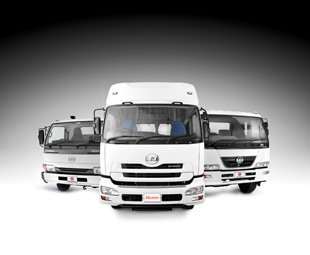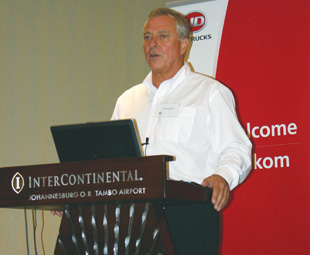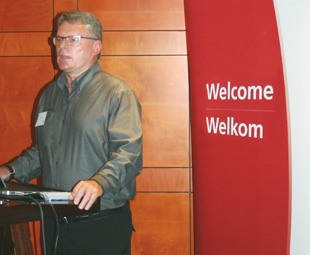Good, and set to get better

As it does every year, UD Trucks presented us with its review of 2011 and visions for 2012. GAVIN MYERS gives you the numbers.
What do you think it takes for a manufacturer to become competitive in any given market during any given year? It’s a mix of much reviewing, closely watching socio-economic developments, planning, forecasting and, ultimately, hoping for the best. The number-crunchers love it.
But for us mere mortals all the figures and graphs can be a little bit confusing. Happily, the folk at UD Trucks took it upon themselves to present the media with both the markets and UD Truck’s own performance for 2011 – plus their predictions for the 12 months that lie before us – in an informative, interactive and easy to understand way.
“We had a good year,” says Johan Richards, CEO of UD Trucks Southern Africa. “Our market forecast was minimally out but everything went according to plan. For this year, we’re optimistic.”
That optimism was echoed by Rory Schulz, general manager for marketing and planning at UD Trucks Southern Africa, who said despite the difficulties during 2011 caused by natural disasters there was much to be thankful for. Schulz said the domestic market ended at 25 851 units. The dynamics changed over 2010, with buses accounting for 3,8 percent of the market, medium commercial vehicles (MCV) 33,7 percent, heavy commercial vehicles (HCV) 18 percent and extra-heavy commercials (EHCV) counting for a large 44 percent. The overall truck market grew 17,39 percent.
 In terms of sales, the EHCV segment was the star performer last year, with increased sales on a year-on-year basis of 35,41 percent to 11 503 units. According to Schulz, that was due to the economy coming out of the recession period and a lot of vehicle replacement therefore taking place. Sales in the MCV segment increased by 15,3 percent to 8 713 units, while a 5,69 percent growth was experienced by the HCV segment, to reach a total of 4 664 units. Bus sales predictably declined, by 37,6 percent to 971 units.
In terms of sales, the EHCV segment was the star performer last year, with increased sales on a year-on-year basis of 35,41 percent to 11 503 units. According to Schulz, that was due to the economy coming out of the recession period and a lot of vehicle replacement therefore taking place. Sales in the MCV segment increased by 15,3 percent to 8 713 units, while a 5,69 percent growth was experienced by the HCV segment, to reach a total of 4 664 units. Bus sales predictably declined, by 37,6 percent to 971 units.
Those figures are according to results released by the National Association of Automobile Manufacturers of South Africa (NAAMSA) – excluding Associated Motor Holdings sales due to them not reporting in 2010, as well as Daimler not disclosing its December results.
“For the year there was still quite enough demand and volume, in spite of some of the problems experienced in terms of supply caused by the tsunami and other related factors,” says Schulz. As a point of interest, UD Trucks achieved 96 percent accuracy on its forecast of 25 187 units for last year. For the year, UD Trucks itself grew 27,67 percent domestically. Says Schulz: “We’re extremely happy with that. Coming off 2 533 units in 2010 we retailed 3 234 units – a much better year.”
So what about UD Trucks’ forecast for 2012? Will this be as good, or even better, a year for both it and the industry? There are many factors that could have a major impact on the way things turn out. “Worldwide, things are dependent very much on how people can create jobs,” notes Schulz. “Our Government has the objective of creating five million jobs. However, it really is a tough task, as we need GDP to be around six or seven percent for that to happen.
“Business confidence is also a far cry from its best-ever level in 2006 of 119 percent; it’s currently at 104 percent for 2011. But we’re all trying to do our part so we can get that confidence up and do our fair share of whatever business there is to be done.”
 Other risks, such as: the road versus rail debate (Transnet recently announced it will assemble an additional 143 locomotives intended for use on main lines to focus on transporting minerals, which will slowly begin to impact on the EHCV market); tolling, and its impact on the cost of transport; the turmoil in the Eurozone trying to avoid a double-dip recession, its sovereign debt crisis, Greece’s bond and, importantly, job creation; friction between Iran, the United States and China about the supply of oil, which could potentially send fuel prices through the roof; and, finally, the shift in a power among developed nations such as the US and those in Europe and their more undeveloped counterparts, such as the BRICS (Brazil, Russia, India, China and South Africa) nations.
Other risks, such as: the road versus rail debate (Transnet recently announced it will assemble an additional 143 locomotives intended for use on main lines to focus on transporting minerals, which will slowly begin to impact on the EHCV market); tolling, and its impact on the cost of transport; the turmoil in the Eurozone trying to avoid a double-dip recession, its sovereign debt crisis, Greece’s bond and, importantly, job creation; friction between Iran, the United States and China about the supply of oil, which could potentially send fuel prices through the roof; and, finally, the shift in a power among developed nations such as the US and those in Europe and their more undeveloped counterparts, such as the BRICS (Brazil, Russia, India, China and South Africa) nations.
“What we’ve done is not to take any of those events into account, which could obviously impact on what would happen,” says Schulz. “It’s based on the trends we have on our statistical models.” In total (and should the Daimler group publish its figures), a market of 29 358 units is predicted for this year. However, if any world event does occur the market could come down by as much as 35 to 40 percent.
UD Trucks forecasts the MCV segment to grow by 11,13 percent to 9 812 units; HCVs to grow by 17,95 percent to 5 525 units. “I think there was a problem in supply of those last year, especially from Japan, which provides 80 to 90 percent of those vehicles. Back orders on HCVs is high, so there’s a little bit of additional recovery that still needs to take place,” says Schulz. UD Trucks expects a total growth of 10,96 percent to 12 932 units in EHCVs; and the bus segment is expected to improve this year by 10,45 percent to 1 089 units.
Adds Richards: “We also foresee a number of possible price increases on trucks in January 2012, as a result of the adverse effect of exchange rates on the local market.” He continues: “Subsequently, we also believe competition will increase among market competitors due to greater product parity, with after sales support and service set to play an increasingly important role in the whole buying cycle.”
And UD itself?
“For next year we’d like to sell around 4 000 units – in comparison to around 3 500 units during 2011. It’s an ambitious task, but we never shy from the challenge and we’re hoping some of the new products (such as the new generation Quon extra-heavy range, due in South Africa in March) will help us achieve it,” concludes Schulz.
Published by
Focus on Transport
focusmagsa

 !
From 1 Apri
!
From 1 Apri

 Big news from FOCUS on Transport + Logist
Big news from FOCUS on Transport + Logist





 FUSO: Driving the Future of Mobile Healthc
FUSO: Driving the Future of Mobile Healthc



 A brand
A brand




 Wondering about the maximum legal load for a
Wondering about the maximum legal load for a 
 The MAN hTGX powered by a hydrogen combus
The MAN hTGX powered by a hydrogen combus

 Exciting News for South African Operators
Exciting News for South African Operators

